| PT-109 | |
| Ordered: | 1942 |
| Laid down: | 4 March 1942 at Bayonne, New Jersey |
| Launched: | 20 June 1942 |
| In service: | 1942 |
| Out of service: | 2 August 1943 |
| Motto: | They were expendable. |
| Fate: | Run down by Japanese destroyer Amagiri (torpedo tube located in May 2002) |
| Notes: | Two crew killed |
| General characteristics | |
|---|---|
| Displacement: | 56 tons (full load) |
| Length: | 80 ft (24 m) overall |
| Beam: | 20 ft 8 in (6.30 m) |
| Draft: | 3 ft 6 in (1.07 m) maximum (aft) |
| Propulsion: | three 12-cylinder Packard gasoline engines 1500 hp each; three shafts |
| Speed: | 41 knots (76 km/h; 47 mph) maximum (trials) |
| Endurance: | 12 hours, 6 hours at top speed |
| Complement: | 3 officers, 14 enlisted men (design) |
| Armament: | 4 21-inch torpedo tubes (four Mark 8 torpedoes), 20 mm cannon aft, four M2 .50 cal .5" (12.7 mm) machine guns (2×2), 37 mm anti-tank gun mounted forward (a field modification) |
| Armor: | gunboat deck house protected against rifle bullets and splinter, some crews fitted armor plate to refrigerators |
After he became president, the incident became a cultural phenomenon, inspiring a song, books, movies, various television series, collectible objects, scale model replicas, and toys. Interest was revived in May 2002, with the discovery of the wreck by Robert Ballard. PT-109 earned two battle stars during World War II operations.
end partial quote from:
Motor Torpedo Boat PT-109 - Wikipedia
Because they speak of plywood Derbies I assume the mahogany wood they used to build these things was assembled as plywood for extra strength bouncing across the water at great speed to avoid being shot out of the water by a battleship. Like fighter planes many of the men on these were lost because if they weren't moving very fast and zigzagging they were very vulnerable to enemy fire.However, they were much much less to build than destroyers or battleships and given the right circumstances they could sink a battleship even if they were also sunk which would be considered a great victory even if the crew in the PT boat was lost in battle. This is why their motto was:
"THEY WERE EXPENDABLE"
begin quote:
PT Boats of World War II: From Home Front to Battle
Introduction
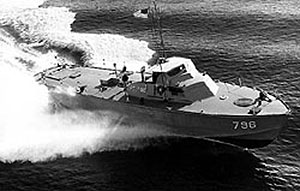
Photo courtesy of Battleship Cove
From Design Competition to Home Front Production
In 1938 the US Navy sponsored a design competition to small boat
builders with a challenge to create a highly mobile attack boat. Prizes
were awarded for the winning PT boat designs. Not long after the U.S.
entry into the war, there were roughly a dozen separate manufacturers of
PT boats from the United States, Canada and Great Britain supplying the
US Navy. Eventually Elco (Elco Motor Yachts) with a factory located in
Bayonne, New Jersey and Higgins Industries in New Orleans, Louisiana
were the dominant two builders with Elco producing the largest number.
In the later years of the war the U.S. Navy standardized the design and
construction of the PT boat. Two basic and distinctly different types
of PT Boats were built for combat with the predominant PT, the 80-foot
long "Elco" boat, and the slightly smaller 78-foot long "Higgins” boat.
By the end of World War II, 399 Elco PTs had been built. Higgins built
199 or 205 PTs, depending on which figures are used.
Elco answered the call to design a PT boat by purchasing a new Scott-Paine motor torpedo boat from England and having it shipped to Electric Boat’s Groton plant. Dubbed PT-9, America’s first PT boat was subjected to numerous sea trials, alone and against other PTs in prototype stages. Over the next two years, PT-9 and subsequent Elco-improved PTs won a series of comparison “plywood derbies” In 1939 Elco doubled the size of its plant and tripled its capacity in order to build PTs. At the height of its PT boat production, Elco employed more than 3,000 men and women working three shifts a day six days a week. They produced, on average, one PT boat every 60 hours. Along with Elco, Higgins Industries made a strong impression with its PT boats in the “plywood derbies”.
Based in New Orleans, Higgins Industries was a small boat company owned by Andrew Jackson Higgins. Higgins built a wide array of boats. Most World War II historians often equate the beach landing crafts used at Normandy and Iwo Jima simply as “Higgins boats”. The first Higgins PT boats were used against the Imperial Japanese forces in the Battle for the Aleutian Islands and in the Mediterranean against Nazi Germany and her allies. They were used to support the D-Day landings on June 6, 1944. PT boats were used for harassing enemy shore installations, supporting friendly troop landings, destroying floating mines, sinking enemy shipping targets, destroying enemy landing barges, rescuing downed pilots, landing partisans behind enemy lines, and attacking enemy island outposts.
Elco answered the call to design a PT boat by purchasing a new Scott-Paine motor torpedo boat from England and having it shipped to Electric Boat’s Groton plant. Dubbed PT-9, America’s first PT boat was subjected to numerous sea trials, alone and against other PTs in prototype stages. Over the next two years, PT-9 and subsequent Elco-improved PTs won a series of comparison “plywood derbies” In 1939 Elco doubled the size of its plant and tripled its capacity in order to build PTs. At the height of its PT boat production, Elco employed more than 3,000 men and women working three shifts a day six days a week. They produced, on average, one PT boat every 60 hours. Along with Elco, Higgins Industries made a strong impression with its PT boats in the “plywood derbies”.
Based in New Orleans, Higgins Industries was a small boat company owned by Andrew Jackson Higgins. Higgins built a wide array of boats. Most World War II historians often equate the beach landing crafts used at Normandy and Iwo Jima simply as “Higgins boats”. The first Higgins PT boats were used against the Imperial Japanese forces in the Battle for the Aleutian Islands and in the Mediterranean against Nazi Germany and her allies. They were used to support the D-Day landings on June 6, 1944. PT boats were used for harassing enemy shore installations, supporting friendly troop landings, destroying floating mines, sinking enemy shipping targets, destroying enemy landing barges, rescuing downed pilots, landing partisans behind enemy lines, and attacking enemy island outposts.
A Future U.S. President’s tale of heroism: PT-109
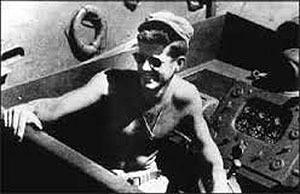
(John Fitzgerald Kennedy Library/National Archives)
The Last Surviving Elco Boat: PT-617
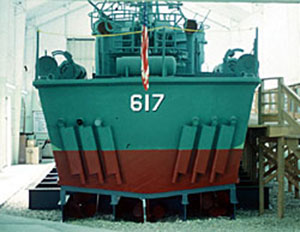
Photo from NPS Maritime Heritage Program collection
The Only Operational PT Boat Remaining: Higgins Built PT-658
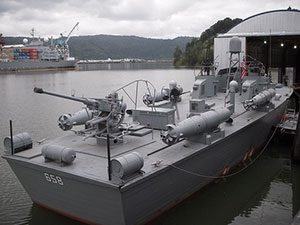
Photo courtesy of the Oregon State Historic Preservation Office/National Park Service
Tail Ender PT-796: One of the last Higgins Builds
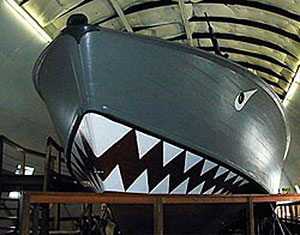
Photo courtesy of Battleship Cove
The National Park Service and Preservation of the Last Three PT Boats
The National Register of Historic Places is the official list of the
Nation's historic places worthy of preservation. Authorized by the
National Historic Preservation Act of 1966, the National Park Service's
National Register of Historic Places is part of a national program to
coordinate and support public and private efforts to identify, evaluate,
and protect America's historic and archeological resources.
National Historic Landmarks (NHLs) are nationally significant historic places designated by the Secretary of the Interior because they possess exceptional value or quality in illustrating or interpreting the heritage of the United States. Today, just over 2,500 historic places bear this national distinction. Working with citizens throughout the nation, the National Historic Landmarks Program draws upon the expertise of National Park Service staff who guide the nomination process for new Landmarks and provide assistance to existing Landmarks.
end quote from:
https://www.nps.gov/articles/ptboats.htm
National Historic Landmarks (NHLs) are nationally significant historic places designated by the Secretary of the Interior because they possess exceptional value or quality in illustrating or interpreting the heritage of the United States. Today, just over 2,500 historic places bear this national distinction. Working with citizens throughout the nation, the National Historic Landmarks Program draws upon the expertise of National Park Service staff who guide the nomination process for new Landmarks and provide assistance to existing Landmarks.
end quote from:
https://www.nps.gov/articles/ptboats.htm
No comments:
Post a Comment